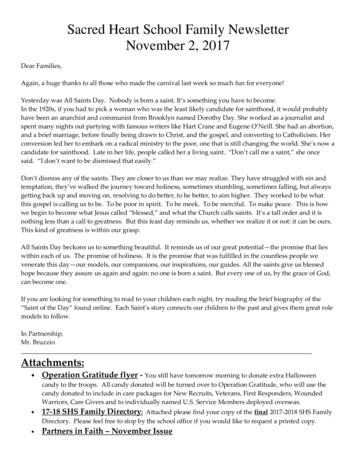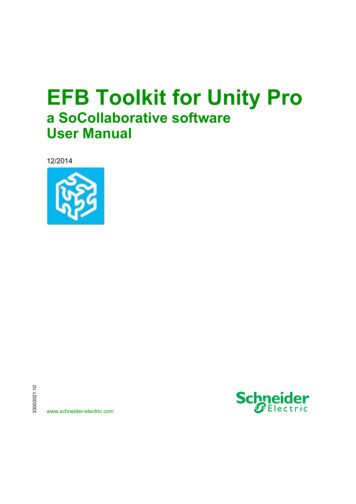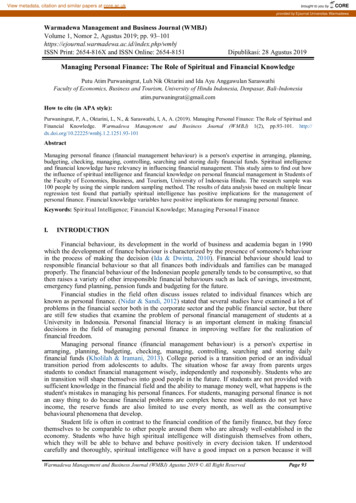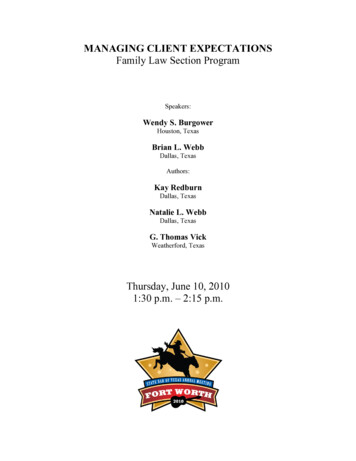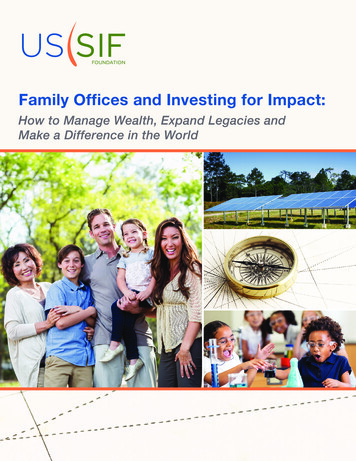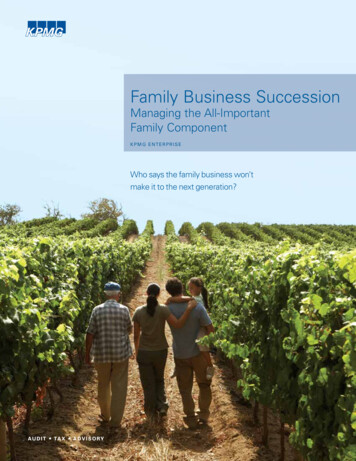
Transcription
Family Business SuccessionManaging the All-ImportantFamily ComponentK P M G E NT E R P R I S EWho says the family business won’tmake it to the next generation?
Family Business SuccessionManaging the All-ImportantFamily ComponentWritten by Grant Walsh 2011 KPMG LLP, a Canadian limited liability partnership and a member firm of the KPMG network of independentmember firms affiliated with KPMG International Cooperative (“KPMG International”), a Swiss entity. All rights reserved.
Table of ContentsIntroductionHow the Book is OrganizedWhat You Will Find in the BookList of HOW TO activitiesWhen Should You Start the Process?3445Section 1 The Business of Family Business:Why Family Business is DifferentDefining Family Business SuccessionAbout This SectionFamily Business Is Different and That Can Be a Good Thing!Impact of the Family Component on the BusinessThe Benefits and Challenges of Family BusinessThe Benefits of Family BusinessThe Challenges of Family BusinessFamily Business Best PracticesThe Business of Family BusinessFamily Business Organizations/InformationOutside Advice and Where to Get ItHow To: Stay CurrentSUMMARY77889911121212131313Section 2 A New Family Business SuccessionModel: Managing the Family ComponentManaging the Family ComponentSuccession ProcessesSuccession ActivitiesDesired OutcomesFamily Business Guiding PrinciplesSUMMARY151515161619Section 3 Management Succession: Integrating theFamily Component into the ManagementSuccession ProcessAbout This SectionFormalizing Management ProcessesTaking the LeadFamily Communication and Decision MakingFamily Business MeetingsHow To: Set Up the Family Business MeetingFamily Council Meetings22232325262729How To: Set Up the Family CouncilFamily Business RulesHow To: Establish Family Business RulesMake a Commitment to Family CommunicationGetting The Family Meetings Started – Outside AssistanceManagement Succession IssuesEmployment of Family MembersGrooming Family Managers to be SuccessorsAssessing Family Member ManagersCompensation for Family MembersManaging Family DisagreementsIntegrating the Family Component in Business PlanningMaking Use of Outside AdviceSUMMARYSUCCESSOR GROOMING TEMPLATE293133343434343637383939404142Section 4 Ownership Succession: Integrating theFamily Component into the OwnershipSuccession ProcessAbout This SectionTaking the LeadEmotions and ComfortFamily Communication and Decision MakingOwnership Succession IssuesOutside AssistanceGovernance (Governing the Family Component)Board of Directors and Board of AdvisersMinority Shareholders: Managing ExpectationsShareholders AgreementSUMMARY4546474747484949515151Section 5: Putting It All TogetherThe End ProductSUCCESSION SELF-ASSESSMENT CHECKLISTSUMMARY555557AppendicesAppendix 1: Sample Family Business RulesAppendix 2: Performance Review Form5964About the Author70 2011 KPMG LLP, a Canadian limited liability partnership and a member firm of the KPMG network of independentmember firms affiliated with KPMG International Cooperative (“KPMG International”), a Swiss entity. All rights reserved.
2 Family Business SuccessionManaging the All-Important Family ComponentIntroductionWhile the majority of family businessowners would like to see their businesstransferred to the next generation, it isestimated that 70% will not survive intothe 2nd generation and 90% will notmake it to the 3rd generation.Family Firm Institutewww.ffi.org 2011 KPMG LLP, a Canadian limited liability partnership and a member firm of the KPMG network of independentmember firms affiliated with KPMG International Cooperative (“KPMG International”), a Swiss entity. All rights reserved.
Family Business Succession3Managing the All-Important Family ComponentThese alarming statistics beg the question:What is going wrong with family businesses and thesuccession process?Surely, the owners of family businesses cannot be held solely responsible for thesesuccession failures. It is the author’s contention that professional advisers to familyowned and -operated businesses need acknowledge that they are in part responsiblefor the dismal performance experienced by family businesses at succession. Far toomuch attention continues to be paid to the technical component of succession(e.g., tax minimization, estate freezes, family trusts, buy-sell agreements, wealthmanagement, etc.) with far too little attention being paid to the people or non-technicalcomponent (family communication, family expectations, family values, familycompetencies, family dynamics, etc.) of the succession process. We will refer to the“people” or “non-technical” component of the family business succession process asthe “family component.”The most critical issuesfacing business-owningfamilies are family-basedissues more than they arebusiness-based issues.Ward, J., Perpetuating theFamily Business, (2004).The existing literature and ongoing research on family business continues to promote theneed to address the family component in the succession process. It is recommendedthat a significant or major portion of the succession activities focus on managing thefamily expectations and the family dynamics. This is achieved by actively integrating thefamily into the process. Professional advisers tend to be more comfortable workingthrough the technical components rather than the family components of the familybusiness succession process. Even though it may be viewed as more challenging,it is the people component that is the most important since it is the people or familymembers who will ultimately decide if the succession works or not. It is the inabilityto effectively manage the family component that has proven to be the major stumblingblock for family businesses in the succession process.Professional advisers to family businesses need to incorporate into their advisoryservices proven strategies to assist family business owners and their successors inmanaging the all-important family component. It is no longer sufficient to inform themof the need to do this. They need to be advised on how to do it. This will be theoverriding theme of this family business succession book.Some family businesses successfully manage their management and ownershipsuccession plans while preserving family and business harmony. There is no reasonmore family businesses cannot achieve similar outcomes. There is a proven approach tofamily business succession planning that produces better results. By applying this provenapproach, we hope to reverse the alarming succession statistics.How the Book is OrganizedThe book is organized in five sections.Section 1: The Business of Family BusinessWhy family business is different from non-family businesses and its impact on thesuccession process.Section 2: A New Family Business Succession ModelBased on the traditional Three Circle Model, this new model focuses on managing the allimportant family component during the succession process. It outlines the family activitiesand desired outcomes during the management and ownership succession processes.Section 3: Management SuccessionActivities that integrate the family members (active and non-active) into the managementsuccession process. Who should take the lead? Family communication (family businessmeetings, family council meetings, family business rules), getting started, addressing themanagement succession issues, grooming the management successors, performancereviews, and compensation for family members are addressed in this section. 2011 KPMG LLP, a Canadian limited liability partnership and a member firm of the KPMG network of independentmember firms affiliated with KPMG International Cooperative (“KPMG International”), a Swiss entity. All rights reserved.
4 Family Business SuccessionManaging the All-Important Family ComponentSection 4: Ownership SuccessionActivities that integrate the family members (active and non-active) into the ownershipsuccession process. Taking the lead, getting started, family communication, addressingthe ownership succession issues, grooming the successors, managing minorityshareholder expectations, family governance, Board of advisers, and shareholderagreement issues are addressed in this section.Section 5: Putting It All TogetherWhat the succession plan looks like once completed. This section also includes afamily business succession self-assessment checklist to allow you to gauge yoursuccession readiness.What You Will Find in the Book1. Why the opportunity to work in a family business is unique and can be mostrewarding.2. The “business” of family business. Family business is different. The need to betterunderstand these differences and how they can impact the succession process.3. A new family business succession model that focuses on managing the familycomponent during the succession process.4. An approach to family business succession planning that produces better results.5. Family business best practices.6. A comprehensive range of proven How-To strategies to assist family businesses inmanaging their family component as they plan for succession and work through theactual process.7. Modified real-life stories and actual tools (samples) used by successful familybusinesses in managing their family component during the succession process.8. A family business succession “Self-Assessment” checklist to allow you to gaugeyour succession readiness.List of How-To activitiesWith respect to item 6 above, the following How-To activities/strategies on howto integrate the family component in the succession process will be addressedthroughout the book:How To: Stay in touch with the business of family business.How To: Get started with the succession process.How To: Manage communication among family members during thesuccession process. Family business meetings (active family members only) Family council meetings (broader family) Developing a set of “family business rules”How To: Manage the “management succession” process. Taking the lead (who should lead the process) Communication among family members (applying the rules) Grooming family managers as successor(s) Performance reviews for family managers (a simple method) Compensation for family members 2011 KPMG LLP, a Canadian limited liability partnership and a member firm of the KPMG network of independentmember firms affiliated with KPMG International Cooperative (“KPMG International”), a Swiss entity. All rights reserved.
Family Business Succession5Managing the All-Important Family ComponentHow To: Manage the “ownership succession” process. Taking the lead (who should lead the process) Communication among family members (applying the rules) Understanding the emotions and providing the necessary comfortto move the process along Grooming family managers as successor(s) Managing minority shareholders expectations Family governance (establishing a board of advisers)How To: Tie all the pieces of the succession plan together. The “management succession” plan The “ownership succession” plan The “family business rules” Shareholders agreementHow To: Assess your family business succession readiness. A “Self-Assessment” family business succession checklistThe book focuses on the need to actively integrate the family into the succession processand more importantly, how to do it. History has proven that the influence of the family(active and non-active family members) on the business is too important not to make itone of, if not the major component, of the succession process. In other words, familybusiness succession is not a one-time event worked out between the owners and theirtrusted advisers. It is a process of working through succession issues with the currentowners and the active family members while keeping the broader family informed of itsoutcomes. The role of the trusted advisers is to ensure that the process actually occurs,that the family members are provided with succession options and professional advice,and that all family members make informed decisions about their individual and collectivefutures in the management and ownership of the family business.When Should You Start the Process?You should consider starting the family business succession process when you havenext-generation family members working full-time in the business in managementpositions.Grant’s CommentsThroughout the book you will find modified real family business successionstories under the title of “Grant’s Comments.” These stories are based on theauthor’s practical experience of advising family businesses with theirsuccession activities. All of these family businesses hit one or more bumpson the road to succession. In each case, a number of the succession activitiesoutlined in the book were applied to either restart the succession process orto get it back on track. Many of the succession challenges are common tofamily businesses. It is likely that you will recognize your family businesssituation in one of the stories. In any event, you will see that you are notalone in trying to manage your family business succession issues. 2011 KPMG LLP, a Canadian limited liability partnership and a member firm of the KPMG network of independentmember firms affiliated with KPMG International Cooperative (“KPMG International”), a Swiss entity. All rights reserved.
6 Family Business SuccessionManaging the All-Important Family ComponentSection 1The Business of Family Business:Why Family Business is Different 2011 KPMG LLP, a Canadian limited liability partnership and a member firm of the KPMG network of independentmember firms affiliated with KPMG International Cooperative (“KPMG International”), a Swiss entity. All rights reserved.
Family Business Succession7Managing the All-Important Family ComponentDefining Family Business SuccessionFamily business succession is the process of transitioning the management and theownership of the business to the next generation of family members. The transitionmay also include family assets as part of the process. Family members typically playa controlling role in both the management succession as well as the ownershipsuccession. As such, the effective integration and management of the familycomponent will have a determining effect on the success of the succession process.There is nothing more difficultto take in hand, more perilousto conduct, or more uncertainin its success than to takethe lead in the introductionof a new order of things.Because the innovator hasfor enemies all those whohave done well under theold condition, and lukewarmdefenders in those who maydo well under the new.Niccolo MachiavelliThe Prince circa 1555Far too often the family business succession process is governed by the technicalcomponents, which are typically worked out between the current owners and theirtrusted advisers (e.g., accountant, lawyer). In these situations, although the impactof the family component may be considered, it is not actively integrated into theprocess. In other situations, where there is an attempt to integrate the familycomponent into the succession process, it is often the process itself or the lack offormality to the process that prevents the desired outcomes from being achieved.There needs to be a departure from the traditional approach to business successionto a customized approach for family business.Grant’s CommentsJust recently, I was asked to moderate a panel of family business successorswho were asked to share their personal experiences during their familybusiness succession process. One of the questions asked of the four panelistswas “If you were able to start all over again, what would you do differently?”Three of the four panelists stated that if they could do it all over again, one ofthe first things they would do is find out more about what other familybusinesses have experienced. The knowledge and experience of other familybusinesses is available and should be used. As one panelist put it, “There’s nogreat reward in trying to do it alone. There’s much to be gained by learningfrom the mistakes and experiences of others.” The message was clear. Thereis family business knowledge as well as family business organizations that canhelp you better understand the business of family business. It’s up to you totake advantage of it.About This SectionFamily businesses are different and what makes them different is the family component.The potential impact the family component can have on the management andownership of the business is such that it needs to be understood and effectivelymanaged. Many family businesses have successfully managed their family componentsand have done so by applying proven family business ‘best practices’. We will examinea number of these throughout the book.In this section, we will discuss the business of family business and the uniquecharacteristics of family business. We will outline the challenges and opportunitiescreated by the ‘family component’ and what needs to be done to ensure that yourfamily business maximizes its opportunities. This section will also provide suggestionson where you can get information on family business and where to look for specializedfamily business advisers/practitioners. 2011 KPMG LLP, a Canadian limited liability partnership and a member firm of the KPMG network of independentmember firms affiliated with KPMG International Cooperative (“KPMG International”), a Swiss entity. All rights reserved.
8 Family Business SuccessionManaging the All-Important Family ComponentFamily Business Is Differentand that Can Be a Good Thing!“ Overall, family businesses are doing better than their non-family businesscounterparts. They are healthier, growing both in terms of revenues andprofits, they are hiring and their owners are optimistic about the future.”Mass Mutual Financial Group, Raymond Institute, Survey ResultsSo why are family businesses outperforming their non-family counterparts? It wouldappear that the unique characteristic of family business (i.e., the family component)and the potential benefits derived from this unique characteristic can provide asignificant competitive advantage.“ While the majority of family business owners would like to see theirbusiness transferred to the next generation, it is estimated that 70%will not survive into the 2nd generation and 90% will not make it tothe 3rd generation.”Family Firm Institutewww.ffi.orgSo why are these same family businesses struggling with the transition process?Once again, the unique characteristic of family business (the family component) andthe challenges it can create, if left unmanaged, are often responsible for thesebusiness failures.Impact of the Family Component on the BusinessThe Three Circle Model outlined below is often used to illustrate the interaction/impactof the family component on the management and ownership of family businesses.The Three Circle Model is represented by the ownership circle, the management circle,and the family circle.FamilyOwnershipManagementThe ownership circle represents the interaction/impact that the owners have on thefamily and on the management of the business. The management circle representsthe interaction/impact that management has on the family and on the ownership ofthe business. The family circle represents the interaction/impact that the family has onthe management and ownership of the business. 2011 KPMG LLP, a Canadian limited liability partnership and a member firm of the KPMG network of independentmember firms affiliated with KPMG International Cooperative (“KPMG International”), a Swiss entity. All rights reserved.
Family Business Succession9Managing the All-Important Family ComponentThe ownership circle and the management circle are common to all businesses. Thefamily circle is unique to family business and is what differentiates it from its nonfamily business counterparts. In many family businesses, the family permeates themanagement and the ownership of the business, making it a significant, if not themajor component in the overall running of the family business. It is easy to see howthe interaction between these three components can create family, management, andownership challenges, as well as provide unique opportunities.The Three Circle Model illustrates how each of the components interacts with eachother and how all three circles meet in the middle, indicating that at some stage ofthe family business, ownership, management, and family are mixed together.Below is a variation of the conventional Three Circle Model that illustrates the significanceor degree of influence that the family component can have. We believe this to be a moreaccurate illustration of a typical multigenerational family business. The family circle tendsto be much more prominent and has a much greater impact on the management andownership of the business. In effect, in many family businesses, the ownership is allfamily and the management is all or primarily family. In these situations, learning how toeffectively manage the family component is even more important.FamilyOwnershipManagementThe ability of family businesses to outperform their non-family counterparts andsuccessfully transfer the business to the next generations is very much dependent ontheir ability to manage their ‘family component’.The Benefits and Challenges of Family BusinessWhat are the unique opportunities/benefits and challenges provided by the familycomponent?The Benefits of Family BusinessThere are many benefits to being a family in business. Unfortunately, far too often,family business is portrayed (especially in the media) as being plagued byintergenerational and sibling conflicts, fiscal irresponsibility, incestuous hiring andpromotional practices, and ongoing legal battles among shareholders. Of course,family business can provide numerouse benefits to family members, non-family 2011 KPMG LLP, a Canadian limited liability partnership and a member firm of the KPMG network of independentmember firms affiliated with KPMG International Cooperative (“KPMG International”), a Swiss entity. All rights reserved.
10 Family Business SuccessionManaging the All-Important Family Componentemployees, and the communities in which these family businesses operate. Thesebenefits often serve to differentiate these family businesses and elevate them to alevel of preferred status and competitive advantage.The benefits derived from being a family in business will vary depending on themakeup and size of the family as well as its stage of evolution (i.e., first, second, orthird generation). The following are some of the benefits that differentiate familybusinesses and can provide a significant competitive advantage.Loyalty – Family members in business tend to demonstrate a greater sense of loyaltyto each other and to the business. They also tend to be more committed to itssuccess and are more passionate about what the business stands for.Legacy – Families in business have an opportunity to create a lasting legacy that bringswith it a sense of accomplishment and a strong sense of pride. Building on the effortsof their forefathers is a strong motivator for subsequent generations to becomestewards of the family business and carry it to new heights in the name of the family.Labour pool – Multigenerational family businesses have access to a labour pool offamily members who, as previously mentioned, tend to be more loyal and morecommitted to the business. Family members also tend to be more flexible in taking ondifferent job functions and filling in for others.Key employees – Key employees (non-family) appreciate and enjoy the unique workenvironment created by a family in business. The workplace tends to be less formal,more hands on, and more personable. Many key employees are treated like extendedfamily and develop a strong bond with the family and the family business.Patience – Family businesses tend to be less driven by short-term financial resultsand are prepared to sacrifice short-term gains for the achievement of longer-termgoals. This allows the businesses to align the deployment of resources with theirstrategic objectives. This long-term approach to investing is often referred to as“patient capital.”Values – Family business owners have the opportunity to teach and pass along theirbusiness and personal values to the next generation of family managers/owners. Familymembers take pride in upholding these family values and build them into their day-to-daywork and personal activities. The work culture is often a reflection of these family values.Career opportunities – Family business owners pride themselves on being able toprovide family members with career opportunities in the business. The family businesscan be a great training ground for family members who aspire to pursue businesscareers elsewhere or within the family business. Family members are also providedwith the opportunity to become managers and owners of the family business.Relationships – The opportunity to work with family members to pursue commonbusiness goals can be a very rewarding experience. Years of bonding among familymembers can create a strong sense of belonging and interdependency. Effectivelymanaging these family relationships will go a long way in ensuring long-term familyand business harmony.Financial rewards – Successful family businesses are able to provide financialrewards to both active and non-active family members. It is not uncommon for familybusinesses to reward family members more than they could obtain elsewhere. This isoften viewed as one of the privileges of being family.Succession – As well as providing career opportunities, family businesses also favourpassing the business along to the next generation of family members. The opportunityto be an owner of the family business or of any business for that matter can be bothmotivating and rewarding.Community and philanthropy – Most family businesses are active in theircommunities. The communities benefit from both the family members as 2011 KPMG LLP, a Canadian limited liability partnership and a member firm of the KPMG network of independentmember firms affiliated with KPMG International Cooperative (“KPMG International”), a Swiss entity. All rights reserved.
Family Business Succession11Managing the All-Important Family Componentvolunteers/supporters and from the family business through financial support andemployment opportunities. This commitment to the community tends to permeate thegenerations and provide family members with the opportunity and rewards that stemfrom this ongoing community support.The Challenges of Family BusinessWhen family business owners were asked“What issues are of the greatest importance and greatest difficulty for you?”They responded1. Resolving conflicts among family members who are in the business2. Formulating a succession plan3. Developing a strategic business plan4. Developing a retirement and estate plan.Mass Mutual Financial Group, Raymond Institute, Survey ResultsMany of what are considered family business benefits can quickly turn into liabilitiesor roadblocks to the business and can create irreversible damage/conflict within thefamily if not effectively managed.Typically, as the family business moves along its generational timeline, more familymembers are actively involved in the business and more family members have aninterest in the activities of the business. Access to the broader family provides manypotential benefits, as identified above, but also brings with it many potentialchallenges. Some of the more common challenges includeConflicting goals/values – Family members, especially between generations, canhave different personal and business goals/values. These goals/values need to beclearly expressed and understood by all, to avoid unnecessary stress and potentialconflict among family members.Conflicting personalities – Everyone is different. Different personalities can often leadto sibling rivalries and intergenerational conflicts. Left unattended or unmanaged, theycan destroy family and business harmony, and in some cases, destroy the business.Expectations – Family members have different expectations from the family and fromthe business. Expectations with respect to employment, management, ownership,compensation, work assignments, training, use of business assets, etc. will varyamong family members. These expectations need to be addressed and managed inorder for the family and the business to operate smoothly. Left unattended orunmanaged, they will negatively impact family and business harmony, and challengethe long-term survival of the businessWork ethic – The work ethic tends to differ significantly as the family business movesthrough its generations. The newer generations tend to be less prepared to invest thekind of time their parents invested in the business. This can cause considerable stressand disaccord between the generations and can also unnecessarily delay the transitionof both management and ownership.Employment of family members – Who gets to work in the family business? Who getswhat jobs? Can spouses and in-laws work in the business? Will employment be based onwhat the families want (bloodline) or what the business needs (competencies)? How arethese employment decisions made? If not effectively addressed, all of these issues canturn into liabilities for both the family and the business.Compensation – Compensation and the inappropriate use of compensation toachieve family or personal goals instead of business goals continues to be one of themost challenging issues facing family businesses. The expectations to be fair are oftenin conflict with the desire to treat family members equally. Emotions can run highwhen this topic is addressed. 2011 KPMG LLP, a Canadian limited liability partnership and a member firm of the KPMG network of independentmember firms affiliated with KPMG International Cooperative (“KPMG International”), a Swiss entity. All rights reserved.
12 Family Business SuccessionManaging the All-Important Family Co
family business succession planning that produces better results. By applying this proven approach, we hope to reverse the alarming succession statistics. How the Book is Organized The book is organized in five sections. Section 1: The Business of Family Business Why family business is different from non

